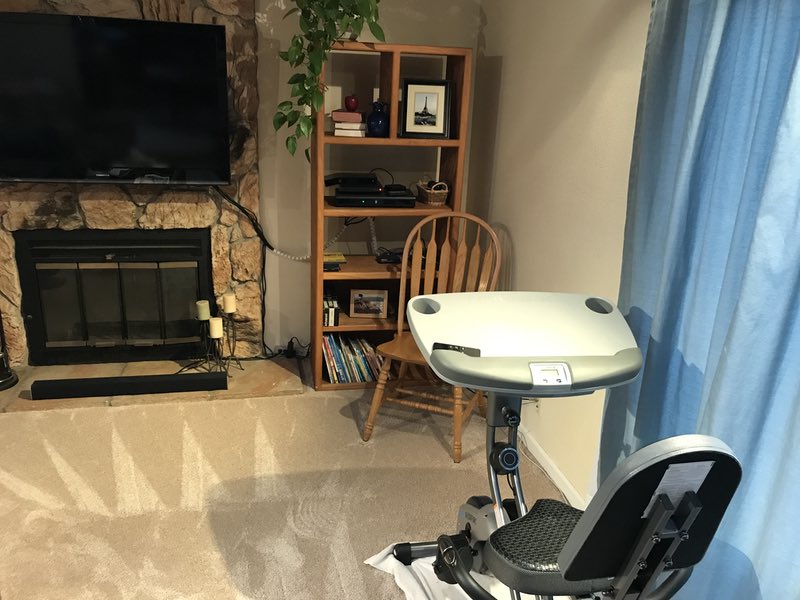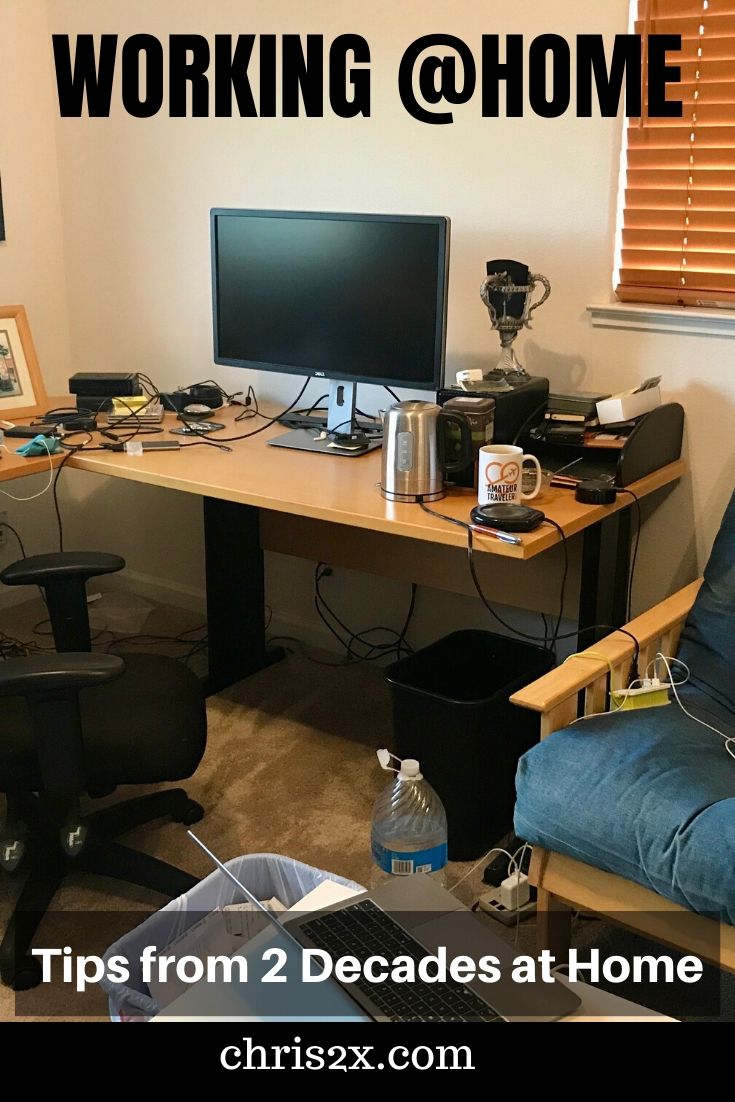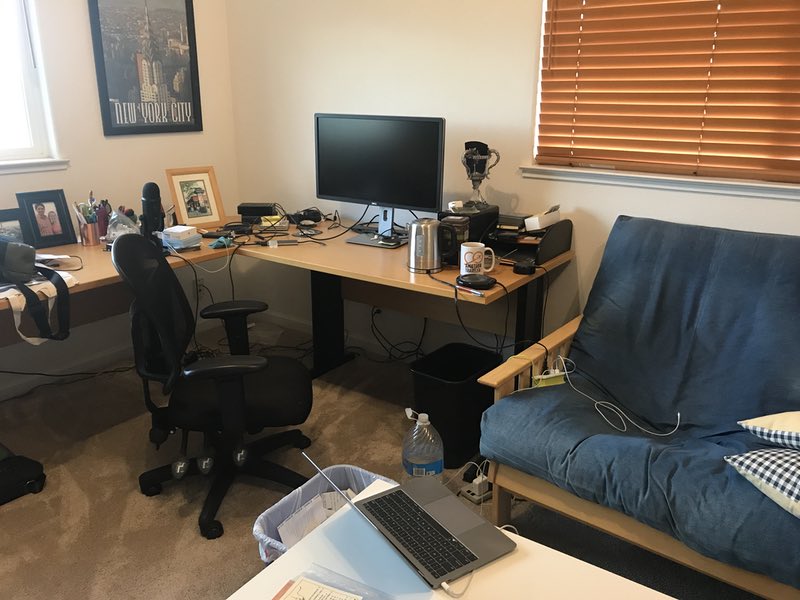I have worked at home for myself or remotely for other companies for most of the last couple of decades. This seems like a good time to document what I have learned over that time. Here are some tips to increase your productivity while you work at home.
Have a schedule
Just because you’re able to skip your commute, doesn’t mean you shouldn’t keep to a regular schedule. I am currently working as a remote engineer for a small start-up company with no physical location. We started each day with a standup meeting at 8 am on Google meetings. It’s a good way to stay in touch, coordinate our work, and also for me on the west coast, define when my day starts.
Stay in Touch
I have coworkers in Portland Oregon, Boston, and the south of France. We don’t work at the same hours for obvious reasons so some of our coordination has to happen through email, our issue tracking system (Jira) or Slack which we use for our chat. See my previous article on managing a remote team.
Ditch the PJs
Right now much of the country is working at home because of a global pandemic. I was surprised to read that some companies like Walmart are selling more shirts and fewer pants than they normally do. This leads me to wonder if people are not wearing pants on their video calls. You can certainly get away with that, but my philosophy is that I am still at work so I still dressed for work. I still shave. I still shower. Of course, since I’m an engineer, dressing for work for me means a clean shirt and jeans.
Have a dedicated workspace… If you can
I remember the first year I worked for my second start-up, which was LiveWorld, I was working at home because we didn’t have an office yet. We had not added onto our house and so much of the work I was doing was while sitting in the family room which I shared with our two school-age kids. While I love spending time with them, it wasn’t the most conducive for getting work done. If you don’t have a dedicated workspace you might think about a signal that you’re working. It might be literally putting on your work hat or putting on your noise-canceling headphones to signal to your family that you’re working.
If you can, make a dedicated workspace so you are still commuting to your work, albeit with much less traffic. I currently have three different spots in the house where I work on a regular basis. Two of these are in a dedicated office.
I have a desk in my office with an external monitor that I can plug into my laptop for those times when I need screen real estate. That is also where are my backup drives are that I can plug-in and my microphone for when I’m recording podcasts. Half the time when I am in my office I am working from a futon with my feet up and my laptop on my lap.

I also have added a new work spot which is a cycle desk. I spend 1-2 hours a day during the workweek sitting and pedaling while I get work done. This is a new addition in the last 6 months and I am surprised how well it works for me. It is in front of the TV in the family room so Joan may hop on it at night while she watches her shows.
Between FOMO and Out of the Loop
 Working remotely it can be easy to feel out of the loop. Many people will miss the personal interaction you get in the office. There is FOMO, Fear of Missing Out. A chat system like Slack or regular video calls can help a lot with that. But that can come at a cost as a group working on Slack may be a constant source of interruption. If you are using a system like Slack you may want to configure the notifications so that it does not beep when anyone in any channel says anything.
Working remotely it can be easy to feel out of the loop. Many people will miss the personal interaction you get in the office. There is FOMO, Fear of Missing Out. A chat system like Slack or regular video calls can help a lot with that. But that can come at a cost as a group working on Slack may be a constant source of interruption. If you are using a system like Slack you may want to configure the notifications so that it does not beep when anyone in any channel says anything.
Figure out which conversations you need to be notified when something new is happening and which ones you can ignore completely or check when you have time. Slack will let you set notifications by channel. It will also let you specify if you will receive an audible notification, will have quiet periods when you are not notified or whether you will be notified only if someone “at mentions” you. My handle in the chat room is @chris. If someone uses that they are trying to get my attention. I want to be alerted of that.
Similarly, your workgroup should decide how often people will check email. I used to tell engineers I managed that I only needed them to check email every couple hours. If I had something more important I would text them, catch them on chat or call them.
Gear
All I really need to get work done is my laptop, a place to sit, a place to plug-in and wi-fi, but I do have more gear that that in my office.
I am rocking a MacBook Air with USB C ports so all of those get plugged in via a small portable USB dock which is actually physically taped to my desk.
Also on my desk is a tea station with an electric hot water kettle. This lets me get more caffeine in my system without going down to the kitchen, which inevitably leads to unneeded snacking calories and distraction. I also have a small electric mug warmer on the edge of the desk that keeps my Amateur Traveler mug warm.
Next to the futon, I have a surge protector where I can plug in my laptop and also a Travel Power Strip Surge Protector with 4 Smart USB Charging Port. This has USB ports so that I can plug in my phone, tablet or my Apple AirPods (earbuds). When I travel, both the USB dock and the travel power strip are small enough to take with me.
Feeling Alone
I am an introvert so I can work at home for days or weeks at a time but your tolerance may be shorter. Even I need to get some face time with old friends or co-workers. During those periods when I am working for myself I have no co-workers so I try and schedule a periodic lunch with old friends. At times like this when I can’t go out I can do the same thing by arranging time to FaceTime the kids or old friends.

